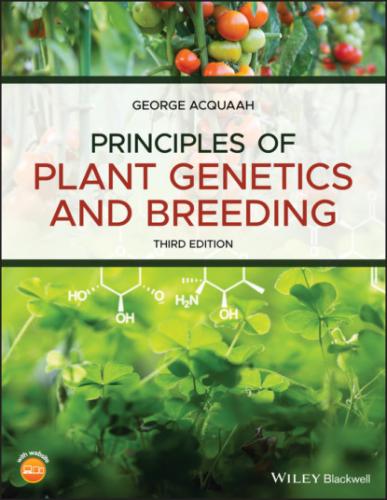A web‐only Glossary
Scan this QR code to visit the companion website.
Principles of Plant Genetics and Breeding
Third Edition
George Acquaah
Bowie State University, Room 315 C, Computer Science Building, Bowie, MD, US,
This third edition first published 2021
© 2021 John Wiley & Sons Ltd
Second edition 9780470664766 published 2012; first edition, 9781405136464, published 2006
All rights reserved. No part of this publication may be reproduced, stored in a retrieval system, or transmitted, in any form or by any means, electronic, mechanical, photocopying, recording or otherwise, except as permitted by law. Advice on how to obtain permission to reuse material from this title is available at http://www.wiley.com/go/permissions.
The right of George Acquaah to be identified as the author of this work has been asserted in accordance with law.
Registered Office(s)
John Wiley & Sons, Inc., 111 River Street, Hoboken, NJ 07030, USA
John Wiley & Sons Ltd, The Atrium, Southern Gate, Chichester, West Sussex, PO19 8SQ, UK
Editorial Office
The Atrium, Southern Gate, Chichester, West Sussex, PO19 8SQ, UK
For details of our global editorial offices, customer services, and more information about Wiley products visit us at www.wiley.com.
Wiley also publishes its books in a variety of electronic formats and by print‐on‐demand. Some content that appears in standard print versions of this book may not be available in other formats.
Limit of Liability/Disclaimer of Warranty
While the publisher and authors have used their best efforts in preparing this work, they make no representations or warranties with respect to the accuracy or completeness of the contents of this work and specifically disclaim all warranties, including without limitation any implied warranties of merchantability or fitness for a particular purpose. No warranty may be created or extended by sales representatives, written sales materials or promotional statements for this work. The fact that an organization, website, or product is referred to in this work as a citation and/or potential source of further information does not mean that the publisher and authors endorse the information or services the organization, website, or product may provide or recommendations it may make. This work is sold with the understanding that the publisher is not engaged in rendering professional services. The advice and strategies contained herein may not be suitable for your situation. You should consult with a specialist where appropriate. Further, readers should be aware that websites listed in this work may have changed or disappeared between when this work was written and when it is read. Neither the publisher nor authors shall be liable for any loss of profit or any other commercial damages, including but not limited to special, incidental, consequential, or other damages.
Library of Congress Cataloging‐in‐Publication Data
Names: Acquaah, George, author. Title: Principles of plant genetics and breeding / George Acquaah. Description: Third edition. | Hoboken, New York : Wiley, 2020. | Includes index. Identifiers: LCCN 2020005450 (print) | LCCN 2020005451 (ebook) | ISBN 9781119626329 (paperback) | ISBN 9781119626343 (adobe pdf) | ISBN 9781119626695 (epub) Subjects: LCSH: Plant breeding. | Plant genetics. Classification: LCC SB123 .A295 2020 (print) | LCC SB123 (ebook) | DDC 631.5/3–dc23 LC record available at https://lccn.loc.gov/2020005450LC ebook record available at https://lccn.loc.gov/2020005451
Cover Design: Wiley
Cover Image: Plants background with biochemistry structure © Marchu Studio/Shutterstock, Fresh tomatoes © Petr Jilek/Shutterstock
To my wife, Theresa, with love and appreciation for uncommon character.
Preface
The third edition of Plant Genetics and Breeding represents a thoroughly overhauled version of its preceding edition, following recommendations and suggestions from users and reviewers. The major changes in the new edition include updated molecular genetics and breeding sections, and the addition of new box reading contributors. The book is copiously illustrated, as previously, to facilitate teaching and learning of the topics.
The book is organized into 14 sections. Section I is an overview and historical perspectives of plant breeding. Chapter 1 in this section provides an introduction to the field of plant breeding, describing its importance to society, while Chapter 2 provides historical perspectives, highlighting the contributions by researchers to knowledge in the field. The two chapters in Section II are devoted to discussing pertinent population and quantitative genetic concepts, to assist the reader in better understanding the practices of plant breeders.
Section III, reproductive systems, is organized into three chapters. Chapter 5 focuses on reproductive and genetic issues as they pertain to self‐pollinated and cross‐pollinated species. Chapter 6 is devoted to discussing the genetic issues associated with crossing plants to reorganize the genetic matrix, while Chapter 7 ends the section with a discussion of issues associated with clonal propagation. Section IV deals with germplasm for breeding. It is impossible to conduct plant breeding without the proper germplasm. Chapter 8 in this section focuses on variation and its genetic basis, while Chapter 9 focuses on domestication of plant species. The discussion includes the dependence of plant breeding on heritable variation. Finally, Chapter 10 speaks to the matter of plant genetic resources used in plant breeding. It includes a discussion of how germplasm is collected and managed for long term use by breeders.
Section V is devoted to discussing common breeding objectives pursued by plant breeders. The discussions include the genetic basis of those traits and the implication in their breeding. Chapter 11 focuses on breeding for increased yield and improving morphological traits that enhance crop productivity. In the ensuing Chapter 12, breeding for selected quality traits is the focus of discussion. A new Chapter 13 focuses on the role of the environment in breeding, with a discussion of climate change and its impact on breeding. Breeding for disease and pest resistance is a major breeding objective in most crops.
